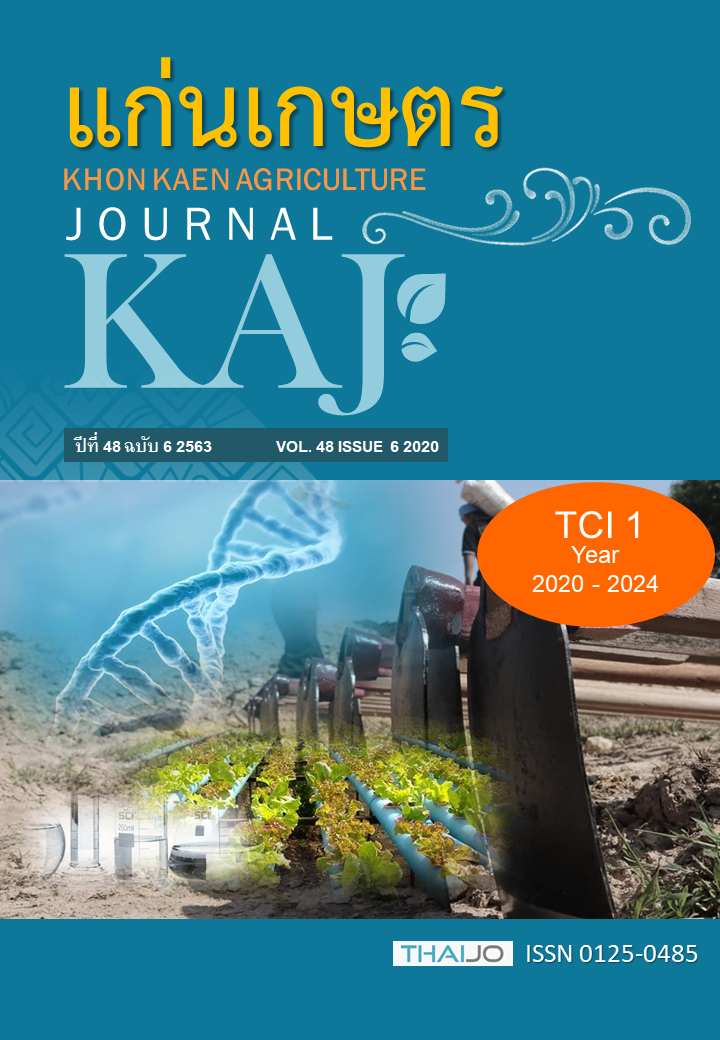ความหลากหลาย และอนุกรมวิธานของเชื้อราปฏิปักษ์ Chaetomium spp. ต่อเชื้อรา Phytophthora palmivora ที่พบในภาคเหนือของประเทศไทย
Main Article Content
บทคัดย่อ
เชื้อ Phytopthora palmivora เป็นเชื้อสาเหตุโรครากเน่าโคนเน่าในทุเรียน ซึ่งทำความเสียหายกับผลผลิตเป็นอย่างมาก แนวทางการแก้ไขปัญหาส่วนหนึ่งพบว่าเชื้อรา Chaetomium spp. บางสายพันธุ์มีคุณสมบัติในการยับยั้งต่อเชื้อสาเหตุดังกล่าวได้ แต่ข้อมูลการจำแนกเชื้อราดังกล่าว มีอยู่อย่างจำกัดจึงทำการสำรวจ รวบรวม และจัดจำแนกเชื้อรา Chaetomium spp. ที่พบบนวัสดุการเกษตรต่างๆ เช่น ฟางข้าว แกลบดิบ กะลากาแฟ ใบปาล์ม หญ้าแห้ง และดิน ในเขตภาคเหนือของประเทศไทย ได้แก่ จังหวัดเชียงใหม่ แพร่ อุตรดิตถ์ และลำพูน โดยแยกเชื้อด้วยวิธี Baiting technique พบว่าสามารถแยกเชื้อรา Chaetomium spp. ได้ทั้งหมด 28 ไอโซเลท เมื่อศึกษาลักษณะทางสัณฐานวิทยา และวิเคราะห์ลำดับนิวคลีโอไทด์บริเวณตำแหน่ง ITS-rDNA โดยเปรียบเทียบกับเชื้อราที่อยู่ในฐานข้อมูล Genbank (NCBI) พบว่าสามารถจำแนกเชื้อรา Chaetomium spp. ได้ทั้งหมด 5 ชนิด คือ Chaetomium globosum, Chaetomium brasiliense, Chaetomium atrobruneum, Chaetomium aureum และ Chaetomium cupreum สุ่มเชื้อราแต่ละกลุ่มนำมาทดสอบประสิทธิภาพของเชื้อรา Chaetomium spp. ต่อการยับยั้งเชื้อรา Phytophthora plamivora สาเหตุโรครากเน่าโคนเน่าทุเรียนโดยวิธี dual culture พบว่าเชื้อรา C. aureum ไอโซเลท MCRC-019, C. cupreum ไอโซเลท MCRC-008, C. brasiliense ไอโซเลท MCRC-020, C. globosum ไอโซเลท MCRC-013 และ C. atrobrunneum ไอโซเลท MCRC-021 มีเปอร์เซ็นต์การยับยั้งเท่ากับ 99.41 53.09 51.62 40.59 และ 32.50 เปอร์เซ็นต์ตามลำดับ ผลการศึกษาที่ได้อาจใช้เป็นแนวทางในการคัดเลือกสายพันธุ์เชื้อรา เพื่อการควบคุมโรคต่อไปได้
Article Details
เอกสารอ้างอิง
อำพล พรหมเมศร์ สรัญยาวัลยะเสวี หัทยา อรุโณทยานันท์ โรเบิร์ต เจมส์ แมกกอฟเวิ่น รัชดาวรรณ ชีวังกูร และชัยวัฒน์ โตอนันต์. 2562. ประสิทธิภาพของราปฏิปักษ์ Chaetomium spp. ต่อ Phytophthora plamivora (P-50) สาเหตุโรครากและโคนเน่าทุเรียน. แก่นเกษตร 47: 1251-1264.
Amadioha, A. C. 2000. Controlling Rice Blast in Vitro and in Vivo with Extracts of Azadirachta indica. Journal of Crop Protection. 19: 287-290.
Brewer, D., W. A. Jerram, and A. Taylor. 1968. The production of cochliodinol and a related metabolite by Chaetomium species. Canadian Journal of Microbiology. 14: 861-866.
Felsenstein, J. 1985. Confidence limits on phylogenies: An approach using the bootstrap. Evolution. 39: 783-791.
Hung, M. P., Pongnak, W., Soytong, K. and S. Poaim. 2015. Biological control of Phytophthora palmivora causing root rot of pomelo using Chaetomium spp. Mycobiology 43: 63-70.
Kirk, P. M., P. F. Cannon, D. W. Minter and J. A. Stalpers. 2008. Dictionary of the Fungi. 10 th Edition.CAB International, Wallingford, UK.
Kunze. G. and J. K. Schmidt. 1817. Chaetomium. Mykologische Hefte nebst einem allgemein-botanischen Anzeiger, Leipzig. 1-2:15.
Maheswari, C. U., N. Mathur, P. Nallathambi and P. T. Devi. 2013. Comparative morphology and taxonomy of the genus Chaetomium Kunze and its species. J Mycol Plant Pathol. 43: 67-71.
Petcharat, V. and Soytong, K. 1991. Chaetomium in soil under para rubber. Songklanakarin Journal of Science and Technology 13: 129-132.
Saitou, N. and M. Nei. 1987. The neighborjoining method: A new method for reconstructing phylogenetic trees. Mol. Bio. and Evo. 4: 406-425.
Somrithipol, S. 2004. Coprophilous fungi. In: Thai fungal diversity (eds. E.B.G. Jones, M. Tanticharoen and K.D. Hyde). BIOTEC, Thailand. 119-128.
Soytong, K. and T. H. Quimio. 1989a. A taxonomic study on the Philippines species of Chaetomium. The Philippine Agriculturist. 72: 59-72.
Sudhir, K., G. Stecher and K. Tamura. 2016. MEGA7: molecular evolutionary genetics analysis version 7.0 for bigger datasets. Mol. Bio. Evol. 33: 1870-1874.
Tamura K, M Nei and S. Kumar. 2004. Prospects for inferring very largephylogenies by using the neighbor-joining method. Proc NatlAcad Sci U S A. 101: 11030-11035.
Von Arx, J. .A., J. Guarro and M. J. Figueras. 1986. The ascomycete genus Chaetomium. Beihefte zur Nova Hedwigia. 84: 1-162.
Wabster, J. and R. Weber. 2007. Introduction to Fungi. Cambridge University Press, UK. 841 p.
Weising, K., H. Nybom, K. Wolff and W. Meyer. 2000. DNA fingerprinting in plants and fungi. CRC Press.
322 p.
White, T. J., T. Bruns, S. Lee and J. W. Taylor. 1990. Amplification and direct sequencing of fungal ribosomal RNA genes for phylogenetics. In: Innis MA, Gelfand DH, Sninsky JJ, White TJ, eds. PCR protocols: a guide to methods and applications. New York: Academic Press Inc. p. 315-322.
Zimand, G., L. Valinsky, Y. Elad, I. Chet and S. Manulis.1994. Use of the RAPD procedure for the identifcation of Trichoderma strains. Myco. Res. 98: 531-534.


